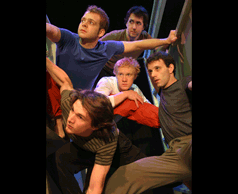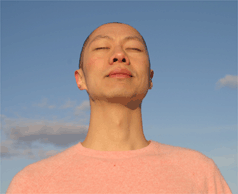How Far Do You Want Me to Go?: Isolated Acts
Lightsey Darst considers overarching questions of performance: expectations, context, the implied contract, in her take on "Isolated Acts Weeks 3 and 4: David DeBlieck and Marcus Young at the Red Eye."


David DeBlieck: “Musclescapes”
David DeBlieck’s “Musclescapes” (an evening of four pieces, two co-choreographed by DeBlieck, all four billed as “acrobatic and architectural adventures by Wicked Sister Dance Theatre”) foregrounds a few ideas in modern dance.
First, sources. In Caroline Sutton Clark’s “The Thunder and the Freshness,” dancers stomp around in tennis shoes, huah! at the audience, form Chinese dragons, and sport ninja gear. With a glance at Clark’s bio, I can guess she’s relying on butoh, an Asian form that mixes dance, acting, and visual elements to create scenes rich in association but (to Western eyes) enigmatic. However, when I watched “The Thunder and the Freshness,” my mind didn’t reach farther than dance cliché to explain it. “Oh, they thought it would be cool to shout at the audience and have the lights go up at the same time,” I thought tiredly. In hindsight, maybe I should have investigated butoh for the reasons behind the movements. But if artists gesture to or assume public knowledge of sources rather than integrating them into the work, must viewers worry about these sources, or may we only look at what is on stage?
“Electrization: the peculiar findings of Doctor Duchenne,” conceived by Jeffrey Bleam, poses a different source question. Duchenne was an eighteenth-century French doctor who studied the effects of electricity on the nervous system. Bleam gives us information about Duchenne through voice-overs, projected photographs, live readings, and acting. The varied delivery and Duchenne’s strange ideas kept me interested, but after fifteen minutes I was worn out and wondering when the performance would really begin. How much context can artists expect viewers to absorb, and how much of a work can be simply relayed information?
This is no small question. Many artists are exploring research and collage; how can they use or share what they’ve gathered? Or, setting research aside, how can artists of varying backgrounds or cultures approach the audience? From the audience’s point of view, how prepared should we be? If the educated viewer appreciates the art more than the neophyte, is the neophyte then not entitled to an opinion? If we’re reading Lolita, must we read the annotated version, knowing that we’ll get more out of it? How educated must viewers be, and whose responsibility is the education?
Second, props. Both “A Lesson in Aviation” and “Electrization” feature aerial dance, the first with a rope parabola, the second with silks. “A Lesson in Aviation,” as the title suggests, explores the possibilities of the parabola; DeBlieck and Clark hang upside down, use the parabola as a giant swing, and alter each other’s positions by tugging down on the rope. DeBlieck and Clark create some striking poses, but because the discovery of poses is the point of the dance, nothing resonates; we’re watching tricks, not emotions, unravel. Aerial dance often has trouble escaping from its circus roots—all that winding and unwinding, those spectacular yet predictable drops—but in “Electrization” Amy Nystrom creates something more than the usual. Her Lady Macbeth sequence, chaotic and fierce, passes up stunts for the red silk tangle of a murderer’s mind. Nystrom doesn’t call attention to her prop; she lets us forget it’s there.
This leads us to “Stalls,” whose central prop is a pair of bathroom stalls (sans toilets), open-ended, doorless, with sturdy bars. In the opening scenes—briefly and luridly lit vignettes—male dancers hang from the top bars, do pull-ups, sit on top of the entire construction, or press themselves against the inside walls in moods ranging from bravado to melancholy to damp desire. Co-choreographers DeBlieck and Noah Bremer explore every configuration of men and refuse to take any easy direction: when you think “Stalls” will fixate on how AIDS destroyed the bathhouse scene, the dance turns funny, men waiting (and cutting) in line for a stall; when you think DeBlieck and Bremer will stay light, violence intrudes—one man sitting on top of the stalls while another lies stretched out beneath. The piece runs long, but it’s impressive for range of emotion, inventive choreography, strong dancing (especially from Galen Treuer and the winning Mark Ruark), and its unusually frank portrayal of the intersection of maleness and desire.
Marcus Young: “And”
Marcus Young glides forward to greet us in a long gray gown buttoned down the front (the work of Feng Ling). The house lights are still on. He asks us to “please touch your nose” and, when we have done so, says, “This is your nose. Thank you.” Music does not come on. He asks us to touch our lips. “These are your lips. Thank you.” We go through a litany of these polite suggestions, including “Please breathe this air. Breathe more,” and are thanked each time.
What’s going on? According to the note in the program, Young would like to call attention to the conventions of the theater and widen the opportunities available to us. Once you have grasped that this performance will go on troubling your ideas of performance, nothing is surprising. Soon two members of the audience are sitting on stage, then more; eventually we are all invited to chairs placed on the stage for us. We are told to whisper, to touch various parts of ourselves, to consider past and present, infinity and future lives. At the end, if we are willing, we are invited to exchange bows with Young.
More interesting than what happens in the performance are the questions it raises for the viewer. Is it better docilely to obey, or to refuse to do what one has no particular desire to do (touch one’s nose, tell a stranger “I love you”)? Obeying is polite; it’s probably what Young would prefer. On the other hand, although all these suggestions are politely worded, Young isn’t exactly polite to offer them. Audience expectations aren’t gospel, but when the existing compact—you will perform and I will sit here in the dark—is broken, the performer has no right to expect that the audience will enter without negotiation into a new compact—you will tell me to do things and I will obey. I worry, too, about the political consequences of this easy obedience. Might we not be led into something unwise? Saying “I love you” to your neighbor might seem innocent, but love is devalued by repetition. I half-expected that Young would turn on us and tell us that we’re bad Zen students, that feeling comes from inside, or that he would lead us in a Nazi salute. What, I wondered, should I do?
I didn’t get to consider this patiently, in the dark; I was forced to act at once. I wasn’t prepared: I was tired and thwarted in my expectation of passive stimulation, suspended action, deferred judgment, indirect communication—all those things which constitute the pleasure of viewing as opposed to doing. Let me walk you through the decisions I made. I elected not to touch my nipples (“These are your nipples”); that’s private. I couldn’t keep my eyes shut; I’m not a believer. I asked my fellow audience members a question (“Is it better to do what he says or not to do what he says?”) while Young was gone, but the lack of response convinced me I should hew to the imaginary line and remain unengaged. I did whisper “I love you, pass it on” to my neighbor; I couldn’t say nothing and changing the message would be mischievous, a lie. I didn’t go on stage when I was asked to; I couldn’t find it in my enlightened self-interest to do so. I did exchange bows with Young as a sign of goodwill. Listen to me temporizing; is this Young’s suggestion, that we must be ready to answer for ourselves at all times? If so, I disagree. Make me active every minute of my life and I’ll be petty and small-minded more than half of it. Let me empty of myself every so often and I’ll be kinder and more tolerant. Also, “And” leaves no way for audience members to be themselves, no way to chart an individual response to command. To do nothing makes you a resentful blockhead; to do everything makes you an appeaser, a push-over. All intermediate courses are capricious.
Young’s note suggests he’s interested in self-improvement. Some people in the audience, in fact, followed his suggestions avidly, as if they were in a yoga class, hoping for enlightenment. In yoga I breathe deeply, but I’m not always willing to work on loving my neighbor more or on letting go of tension. I am always ready, though, to consider ideas. For the questions that have made me think so hard, then, I have Marcus Young to thank.